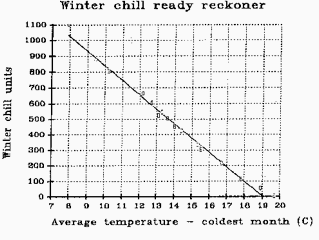As I look out my back window at the quince and the peach beginning to bloom I am reminded of the wonders of fruit trees.
The weather is always a little unpredictable around this time of year, when the wind whips and the petals beak and swirl in whirlpools in the air. Poor weather conditions, during flowering are just one of the things that leads to poor fruit production. Excessive rainfall or over watering will produce weak sappy growth and little fruit, whilst a shortage of water will result in flower and/or fruit drop. Stress from high temperatures will lower flower development where as cool temperatures lowers the viability of the pollen. Cold, wet and windy conditions during bloom can reduce insect activity in the area.
Most fruiting plants have specific temperature ranges in which pollen viability and fertilization success are at a peak. Changes from these temperatures often results in low fruit yields. In temperate climates many fruit varieties require a certain amount of cold weather of the Upper Mountains in order to fruit normally. This requirement which varies with the cultivar is referred to as chill hours being accumulated cold-season hours below 7°C. For more on chill hours check out our previous post The Chilling Facts of Life
You may notice trees in blossom buzzing with bees at the moment, that’s our glorious pollinators are getting busy as the weather warms up. Pollination is a key concept in fruit production and consequently must be understood in order to maximize productivity and yield. Only pollinated flowers can bear fruit. And in the case on dioecious species (6% of plants only) like kiwi fruit – then only female plants bear fruit. To further complicate things some fruit trees like apple trees are cross-pollinators, this means they are incompatible with their own pollen. So generally speaking they require pollen from another apple of a different variety (including crab apples) in order to produce fruit. In a cross-pollinated system, honeybees, wasps and other pollinators allow the transfer of pollen from one plant to another as they drop a little pollen collecting from plant to plant.
For two such plants to successfully pollinate each other not only does their pollen have to be compatible but they have to be producing the pollen at the same time, If there is no source of pollen within the optional distance and flowering at the same time, pollination will not take place and fruits will not form. Plums and pears are cross pollinators too. Talk to your neighbours about what fruit trees they have already or are thinking about buying, if they’re within 500m you can cross pollinate your trees with theirs. If neither you nor your neighbours have any compatible trees nearby, it is possible for branches with blossoms to be brought in from a different area and placed in drums of water close to the tree requiring pollination.
Self-pollinating fruit trees include apricot, nectarine, peach, sour cherry as well as currant, gooseberry, blueberry, strawberry and raspberry plants. They do not require an outside pollen source, although they often seem to produce better if there is one. I find the term ‘self pollinating’ a bit misleading, we still need our insects friends to spread the pollen from flower to flower, and trees will often be more produce more prolifically if compatible cross pollinating plants are in the vicinity.
Pears are similar to apples, with the notable exception that pear blossoms are much less attractive to bees, due to lower sugar content than apple or contemporaneous wildflower nectar. To make up for thiees hives are often introduced in commercial enterprises.
Don’t worry too much if you tree doesn’t produce fruit every single year. Talk to local fruit growers about any regular (or irregular) fruiting patterns they’ve observed, local knowledge can help demystify the variations in our production cycles, the links between weather and other environmental patterns are not always obvious. Some trees only flower every other year, this is known as alternate flowering. It’s especially common in apple and crabapple trees. Some say that thinning excess fruits in an “on” (flowering) year will help to conserve the plant’s resources and reduce the occurrence of subsequent “off” years.
While there are reports of 200 year old apple trees still going strong, it’s not uncommon to find that older trees decline in fruit production. If you inherit a slightly sad or neglected old fruit tree, never fear, a good pruning & a little TLC can make a big difference.
Make friends with the Heritage Apple trees at Blue Mountains Organic Community Gardens, which we’ll be visiting as part of our upcoming Spring PDC.
Thanks for jnyemb and daveeza on flickr for sumptuous Spring pix and info from:
Dan & Dan Forest Services Yass NSW- www.dananddan.com.au
EarthWood – Our Fruit -users.netconnect.com.au
(I recommend a good old wassail around any fruit trees, all that good cheer certainly can’t do any harm)










 The band of blue is also narrowing as it fades meaning winter is also getting shorter. In the upper mountains its a familiar story, the snows don’t come down in big drifts like they used to. In Katoomba if the temperature rises as predicted, we’ll see an increase in temperature by 2 °C on average over the year, which will bring Katoomba chill hours down to about 1000. That will knock off very few varieties out of production. In Springwood, which is currently marginal for high chill requirement fruits, its a different story. That 2° C increase in Springwood would drop their chill hours well below into 900 , so they’ll either have to get a bit nifty with engineering cooler microclimates around their existing chill requiring trees or perhaps get more familiar with trees traditionally grown at latitudes nearer the tropics.
The band of blue is also narrowing as it fades meaning winter is also getting shorter. In the upper mountains its a familiar story, the snows don’t come down in big drifts like they used to. In Katoomba if the temperature rises as predicted, we’ll see an increase in temperature by 2 °C on average over the year, which will bring Katoomba chill hours down to about 1000. That will knock off very few varieties out of production. In Springwood, which is currently marginal for high chill requirement fruits, its a different story. That 2° C increase in Springwood would drop their chill hours well below into 900 , so they’ll either have to get a bit nifty with engineering cooler microclimates around their existing chill requiring trees or perhaps get more familiar with trees traditionally grown at latitudes nearer the tropics.




